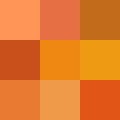| Rose | |
|---|---|
| | |
| | |
| Hex triplet | #FF0080 |
| sRGB B (r, g, b) | (255, 0, 128) |
| HSV (h, s, v) | (330°, 100%, 100%) |
| CIELChuv (L, C, h) | (55, 143, 355°) |
| Source | By definition [1] |
| ISCC–NBS descriptor | Vivid pink |
| B: Normalized to [0–255] (byte) H: Normalized to [0–100] (hundred) | |
Rose is the color halfway between red, magenta and white on the color wheel, on which it is at hue angle of 330 degrees.
Contents
Rose, or vivid pink is one of the tertiary colors on the HSV (RGB) color wheel. The complementary color of rose is spring green. Sometimes rose is quoted instead as the web-safe color FF00CC, which is closer to magenta than to red, corresponding to a hue angle near 320 degrees, or the web-safe color FF0077, which is closer to red than magenta, corresponding to a hue angle of about 340 degrees.









